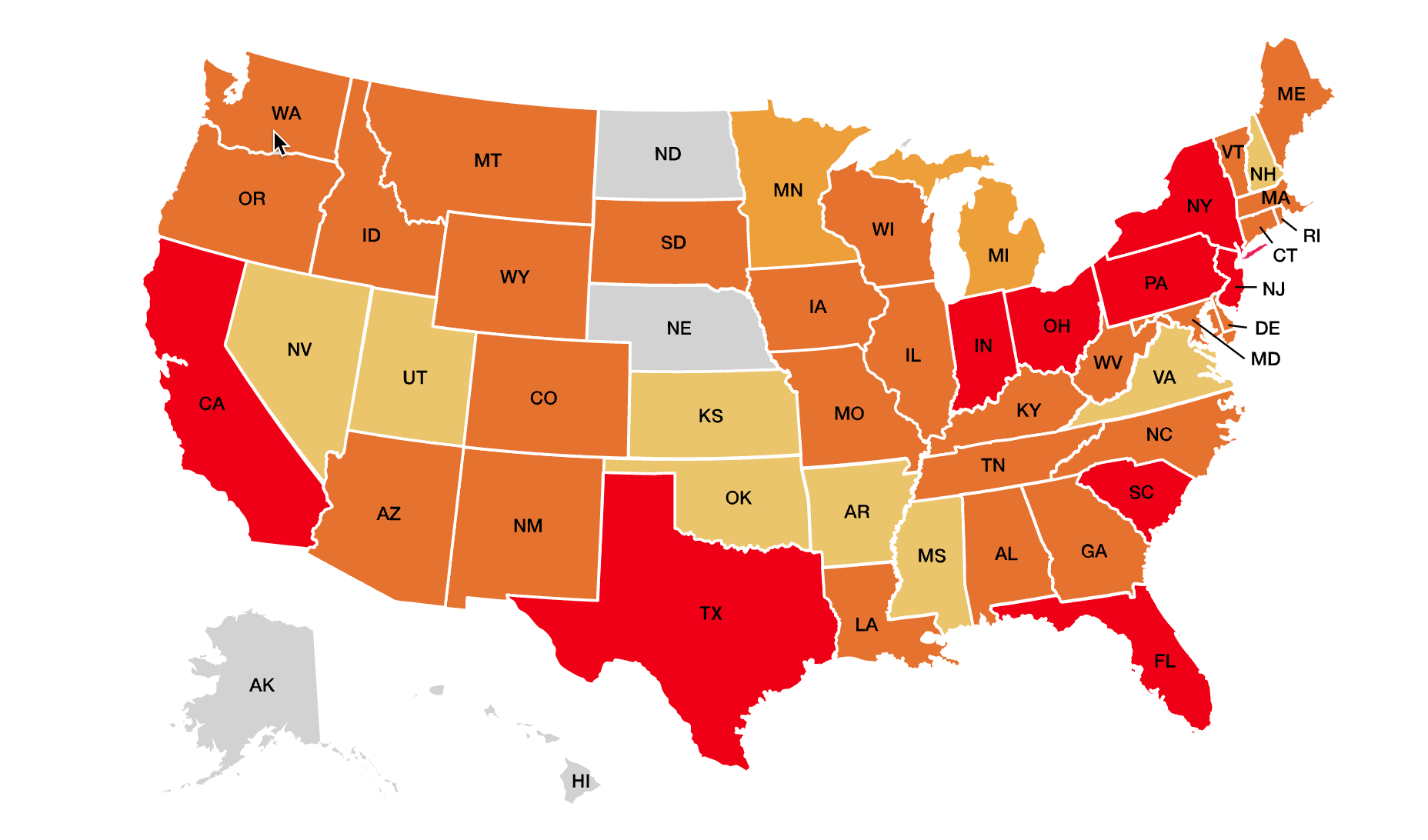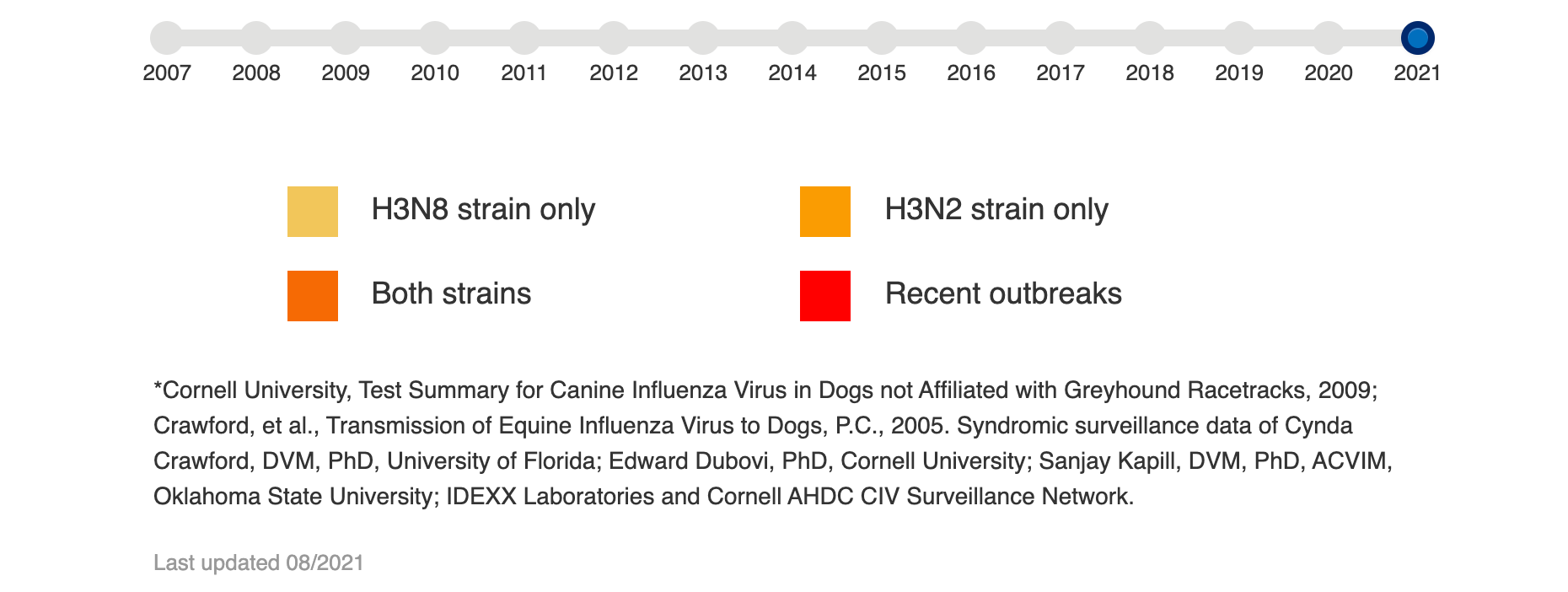Summary:
Canine influenza or Dog flu (H3N8, H3N2) is
a relatively new disease that has a low mortality rate. The majority of recent cases in the United States are from the strain H3N2. The disease is
highly contagious and is spread from dog to dog. Canine influenza has
been reported in 18 states in the U.S. It spreads in the same way influenza viruses and human
flu spreads, through the air via respiratory secretions and by touching
or drinking from
contaminated objects, or by sharing leashes and bowls. The virus can
last on surfaces for 48 hours and 12 hours on human hands.
Symptoms are similar to those found in an
upper
respiratory infection
- Low grade fever (103°F)
- Runny nose
- Appetite loss
- Cough
Symptoms in more chronic cases include fever, shortness of breath and even coughing up blood. Since it is hard to distinguish the flu from
respiratory issues that heal on their own, it is advised that pet
owners visit a veterinarian. There is a chance that in complicated
cases of the disease, a dog can develop secondary bacterial infections and pneumonia
if left untreated. Asymptomatic dogs (those that do not show symptoms)
can still be ill (about 20% of call cases).
There is a vaccine available that is recommended for dogs that frequently contract the canine influenza virus, or that are frequently in close contact with other dogs that get the disease, such as in a kennel (vaccine protects against H3N2 and H3N8 strains.). Vaccination may reduce illness duration and severity.
There is no treatment other than having to work through the 7
day infectious cycle and to guard against the worsening of the disease
into bacterial pneumonia. The cost of dog flu vaccination is from $35
to $45.
There is no evidence that the flu in dogs can spread to people. However, H3N2 can cause respiratory illness in cats.
Dogs should avoid contact with dogs that were exposed to dog influenza for 28 days after exposure."

What is Dog Flu?
Dog flu is respiratory disease that is a relatively new strain of canine influenza viruses. This virus, belonging to the influenza A family, is a mutated strain of an equine influenza virus that has been detected in horses for more than 40 years. It was first reported in January 2004 at a greyhound track in Florida. Since then, it has been reported in as many as 18 other states. Dogs in shelters, humane societies, and boarding facilities are at particular risk and are often vaccinated.
There have been confirmed cases in 30 States in the U.S. Dogs are highly susceptible to the disease since they have no immunity from prior infections. These viral infections are easily spread among dogs.

The Rate of Infection Can Reach 100%, with 80% Showing Symptoms.
Podcast
Canine Influenza Podcast Update from the
American Veterinary
Medical Association
Dogs can only catch the flu from other dogs. It is transmitted through the air, usually by dogs coughing or sneezing on each other. If your dog has not been around any other dogs in the past week or so, then he can’t have the flu.
The incubation period in most cases is 2 to 5 days. Infected dogs can spread the flu for 7 to 10 days after symptoms appear. Dogs that show no clinical signs of canine influenza can also spread the disease.
Humans cannot catch the flu from dogs; it is a different strain of flu that infect dogs.

Source: Cornell University Baker Institute for Animal Health
Symptoms
Dog flu symptoms in its mild form include sneezing, nasal discharge, runny discharge from the eyes, lack of energy, reduced appetite, low grade fever, and a persistent cough and stuffy nose that can last for up to three weeks. It can resemble kennel cough and other respiratory diseases. Because of the similarity of the two diseases, it is recommended to dog owners that a "better safe than sorry" approach be taken, with an immediate trip to the veterinarian for evaluation.
Cough can persist for 2 to 3 weeks. Nasal discharge is more likely than sneezing. Most dogs recover with no complications.
In severe cases, high grade fever (104 - 106 degrees) difficulty breathing (increased respiratory rate). Secondary bacterial pneumonia may set in if left untreated.
States With Dog Flu Reports (as of 2/10/2023)
One or both strains of dog flu have been seen in 46 U.S. states.
 States Where Dog Flu H3N8 Strain or H3N2 Strain Has Been Reported
States Where Dog Flu H3N8 Strain or H3N2 Strain Has Been ReportedSource: dogflu.com

Diagnosis
There are two types of tests available for dog flu. In dogs that have been ill for less than 4 days, a veterinarian can collect swabs from the nose. In dogs that have been. There is a blood test that is only accurate seven days after the onset of symptoms that will show antibodies to the flu virus, meaning that your dog’s body is fighting off the virus, but that doesn’t help if you take your dog to the vet when he first gets sick. The other method uses Given the need to wait the seven days, your veterinarian will probably make a preliminary diagnosis based on the symptoms and medical history you provide.
If he has been around another infected dog, and he has symptoms of the flu, then he may well have the flu. Since treatment for the flu is similar to treatment for many other respiratory infections, having an exact diagnosis may not really matter anyway.
Treatment
There is no treatment since canine influenza is a viral infection. It just needs to move through its infectious cycle, which is usually 7 days. Most dogs infected will recover without any treatment. The virus will simply run its course. Keep your dog warm and dry. She may not have much or an appetite, but encourage her to drink plenty of water.
In some cases, secondary infections like pneumonia may set in. In these cases, antibiotics are required. These are given orally, usually for 14 days. Your vet may want to give your dog antibiotics anyway, just in case he has something besides the flu virus.
In very severe cases, dogs may require intravenous fluids and antibiotics. This will require hospitalization which is unusual.
Mortality Rate
Dog influenza is not usually fatal. IF left untreated, it can lead to more serious life-threatening pneumonia. 6 to 8% of dogs that get dog flu will die from the disease if left untreated. In these cases the disease is characterized as pneumonia. Most cases (80%) are mild. The mortality rate of 2% is seen primarily in dogs that have underlying diseases, have a weak immune system or are in poor condition according to VIN News.
Prevention
Vaccination
There are three dog influenza vaccines. One is for H3N8 and one is for H3N2 and another covers both types (a bivalent vaccine). The vaccines are made out of killed vaccines, so vaccinated dogs will not shed virus. They do not provide 100% protection (like human flu vaccines). Also like human vaccines, vaccinated dogs may have milder symptoms. Many veterinarians do not recommend the canine influenza vaccine unless a dog is at high risk. This might include dogs that frequently are exposed to other dogs such as in dog parks or kennels.
The vaccine requires two doses, 2 to 4 weeks apart, followed by revaccination. Often dogs that are vaccinated for kennel cough are vaccinated for canine influenza as well. Most dog shelters and veterinarians offer the vaccine a low cost ($35 to $45).
The dog flu vaccine is a killed viral vaccine, so there is no potential for the vaccine to cause the canine influenza virus by itself. It is safe for dogs 6 weeks of age or older. Like other dog influenza vaccines, it may not prevent infection of the dog, but will reduce the severity of the clinical disease, it will reduce the progression of the disease to pneumonia, and reduce the time that a dog can spread the disease to other dogs.
Brochures
Facts About Canine Influenza (PDF Download)
Ask Our Vet A Question And We Will Answer It For Free
Have A Dog Flu or Respiratory Question For Our Vet?
Do you have a Dog Flu Health Question for our Editors or a Helpful Story to Share? Please include information such as age, sex, breed, medical history, symptoms and medications.
We will do our best to get back to you quickly (depends on how many questions we receive each day). Include important information such as breed, sex, age, medical condition, respiratory, breathing and other symptoms (changes in behavior, cough etc.), test results and history of recent visits to the veterinarian.
If you do require an immediate response we suggest using this online dog veterinary service that is available now.
Vet Suggestions and Other Reader Questions
Click below to see contributions from other visitors to this page...
How to Treat Dogs With The Flu Not rated yet
Reader Question: Dog flu treatment
How can I help my dog to breathe? Her nose looks like it is stuffed with dried mucus.
Suggestion From Our …
Cleaner for Dog Flu Not rated yet
Reader Question: Disinfectant Cleaner to remove Dog flu virus from kennel.
We are an 80 kennel boarding kennel in Michigan. We use Nolvasan S disinfectant, …
References
American Veterinary Medical Association
Centers for Disease Control and Prevention
Fast
Facts on Canine Influenza
University of Illinois
College of Veterinary Medicine
AVMA
“Canine Influenza Backgrounder”.
College
of Veterinary Medicine
Washington State University
Rubenstein, Carin. “Virulent Dog Virus Hits Area Kennels”.
New York Times. 25 September 2005.
“Control of Canine Influenza in
Dogs-Questions, Answers, and
Interim Guidelines”.
AVMA. 2005. 20 April 2006.
Crawford, P.C.
“Transmission of Equine Influenza Virus to Dogs”
Science Express.(2005)
“Fast Facts on Canine Influenza” Pet Columns at CVM at UIUC
